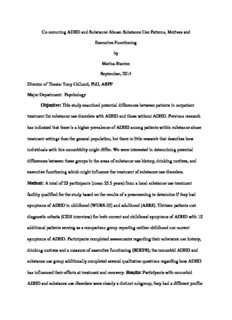
Co-occurring ADHD and Substance Abuse PDF
Preview Co-occurring ADHD and Substance Abuse
Co-occurring ADHD and Substance Abuse: Substance Use Patterns, Motives and Executive Functioning by Marina Stanton September, 2014 Director of Thesis: Tony Cellucci, PhD, ABPP Major Department: Psychology Objective: This study examined potential differences between patients in outpatient treatment for substance use disorders with ADHD and those without ADHD. Previous research has indicated that there is a higher prevalence of ADHD among patients within substance abuse treatment settings than the general population, but there is little research that describes how individuals with this comorbidity might differ. We were interested in determining potential differences between these groups in the areas of substance use history, drinking motives, and executive functioning which might influence the treatment of substance use disorders. Method: A total of 23 participants (mean 25.5 years) from a local substance use treatment facility qualified for the study based on the results of a prescreening to determine if they had symptoms of ADHD in childhood (WURS-25) and adulthood (ASRS). Thirteen patients met diagnostic criteria (CIDI interview) for both current and childhood symptoms of ADHD with 10 additional patients serving as a comparison group reporting neither childhood nor current symptoms of ADHD. Participants completed assessments regarding their substance use history, drinking motives and a measure of executive functioning (BDEFS); the comorbid ADHD and substance use group additionally completed several qualitative questions regarding how ADHD has influenced their efforts at treatment and recovery. Results: Participants with comorbid ADHD and substance use disorders were clearly a distinct subgroup; they had a different profile for substance use history, including using more overall types of substances as well as cocaine and prescription stimulants; were more likely than those with substance use alone to initiate alcohol, nicotine, and marijuana at an earlier age; and had used alcohol for a longer period of time. Motives for drinking did not differ although the ADHD group had somewhat more conduct problems in childhood. Both groups reported significant difficulties with executive functioning, but those with comorbid ADHD and substance use disorders reported significantly more problems with executive functioning in daily life than those without ADHD. Although the number of past treatment episodes did not differ, qualitative responses suggested ways ADHD might impact treatment. Conclusion: More research is needed to better characterize comorbid ADHD and substance use disorder and determine the implications such differences might have on treatment and recovery efforts. Co-occurring ADHD and Substance Abuse: Substance Use Patterns, Motives and Executive Functioning A Thesis Presented To The Faculty of the Department of Psychology East Carolina University In Partial Fulfillment of the Requirements for the Degree Master of Arts in Psychology by Marina R. Stanton September 2014 © Marina Stanton, 2014 Co-occurring ADHD and Substance Abuse: Substance Use Patterns, Motives and Executive Functioning by Marina R. Stanton APPROVED BY: DIRECTOR OF THESIS: ________________________________________________________ Tony Cellucci, PhD COMMITTEE MEMBER: _______________________________________________________ Lesley Lutes, PhD COMMITTEE MEMBER: _______________________________________________________ Christy M. Walcott, PhD CHAIR OF THE DEPARTMENT OF PSYCHOLOGY: ________________________________ Susan McCammon, PhD DEAN OF THE GRADUATE SCHOOL: ___________________________________________ Paul J. Gemperline, PhD ACKNOWLEDGEMENTS I would like to thank Dr. Tony Cellucci, my committee chair and mentor, for his dedication and perseverance in helping and supporting me throughout this journey. I would also like to thank my co-chair, Dr. Leslie Lutes for her insight and ability to negotiate, without which this thesis might never have been finished, and Dr. Christy Walcott for her support and assistance in this endeavor. I would also like to thank PORT Human Services for their patience and the use of their facilities. I’d like to thank my amazing friends and family for their support and encouragement— often in the form of babysitting my sweet son Benjamin. Finally, I would like to thank my amazing and supportive husband, Stephen, who stuck with me, even though I’m not sure he thought I would ever finish! TABLE OF CONTENTS Title Page…………………………………………………………………………………………..i Copyright Page……………………………………………………………………………………ii Signature Page……………………………………………………………………………………iii Acknowledgement Page………………………………………………………………………….iv Table of Contents…………………………………………………………………………………v List of Tables .................................................................................................................................ix CHAPTER 1: LITERATURE REVIEW………..………………………………………………..1 Substance Use Disorders……………………………………………………………….....2 Attention Deficit Hyperactivity Disorder………………………………………………....5 Conduct Difficulties………………………………………………………………………7 Comorbidities………………………………….…………………………………………10 Comorbid ADHD and Substance Use Disorders………………………………...10 Prospective Longitudinal Studies………………………………………..11 Retrospective Studies………………………………………………....….12 Conduct Disorder, and ADHD…………………………..…………………….....13 What Distinguishes Substance Abuse Patients with ADHD…………………….16 Substance Abuse Patterns………………………………………………………………..17 Motives for Use…………………………………………………………………………..22 Executive Functioning…………………………………………………………………...28 Executive Functioning in ADHD………………………………………………...28 Executive Functioning in Substance Abuse………………………………...……31 Combined Influences…………………………………………………………….34 Purpose of the Present Study and Research Questions…………………………………..34 CHAPTER 2: METHODS………………………..…………………………………..………….36 Participants………………………………………………………………..……………...36 Procedures………………………………………………………………………..………36 Measures………………………………………………………………………...……….38 ADHD Screening (WURS/ASRS)……………………………………………….38 Substance Abuse History Measures….……………………………………...…...40 Conduct Problems Measure….……………………………………………...…...41 Desired Effects of Drinking (DEOD)……………………………………………41 Barkley Deficits in Executive Functioning Scale (B-DEFS)……………………43 Composite International Diagnostic Interview (CIDI)…………………………..44 Qualitative Questions about ADHD and Substance Use…………………....…...45 Ethical Issues……………………………………………………………………...……..46 Data Analysis……………………………………………………………………....…….47 CHAPTER 4: RESULTS.………………………..…………………………………..……….….48 Descriptive Statistics.…………………………………………………………………….48 Group Classification………………………..……………………………………………49 Research Questions………………………………………………………………………52 Research Question #1: Substance Use Patterns………………………………………….52 Lifetime Types of Drugs Used……………………………………………….…..53 Total Number of Substances Used and Primary Drug of Choice………………..54 Use of Specific Substances………………………………………………….….. 55 Treatment History…………………………………………………………..……60 Research Question #2: Motives for Substance Use……………………………………..62 Research Question #3: Executive Functioning………………………………………….66 Summary Analyses of Group Prediction……………………………………………..….71 Qualitative Analysis……………………………………………………………………...77 Question 1………………………………………………………………………..77 Question 2………………………………………………………………………..78 Question 3……………………………………………………………………..…79 Question 4……………………………………………………………………..…80 Question 5………………………………………………………………………..81 CHAPTER 5: DISCUSSION…………………..…………………………………..……….…....84 Major Findings…………………………………………………………………………...84 Study Plan and Final Sample…………………………………………………………….85 ADHD and Conduct Disorder……………………………………………………………86 Substance Use History……………………………………………………………..….…87 Lifetime Types of Drugs Used…………………………………………………...88 Total Number of Substances Used and Primary Drug of Choice………………..88 Age of Onset of Substance Use……………………………………………….…89 Substance Variables Summary………………………………………………..…90 Motives for Substance Use……………………………………...……………………….90 Differences in Executive Functioning……………………………………………..…….94 Treatment History and Impact on Treatment…………………………………………….96 Study Limitations…….………………………………………………………...………..98 Clinical Implications (including prevention)…………………………………………...100
Description: